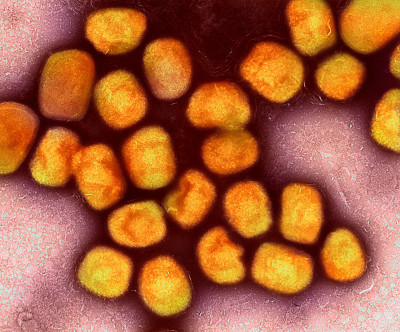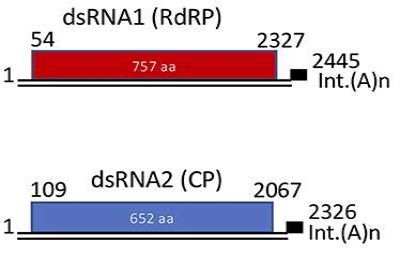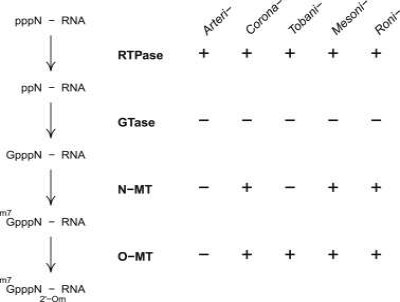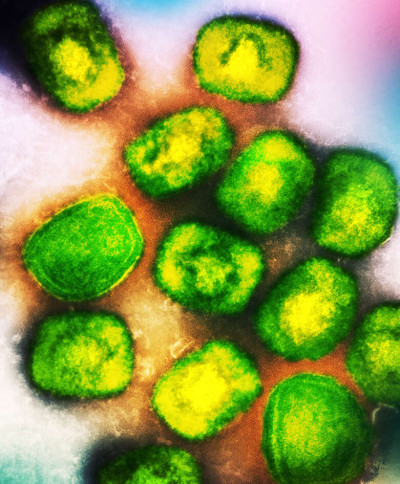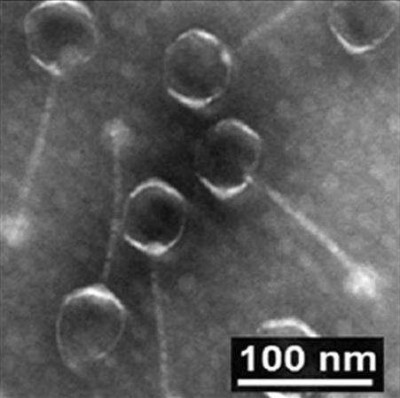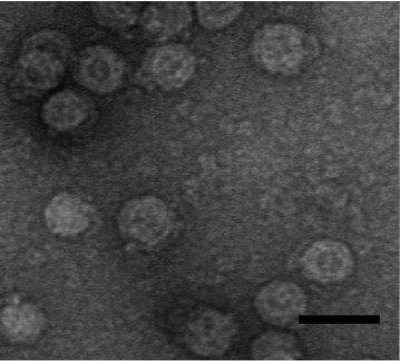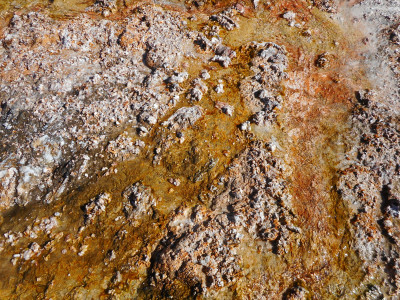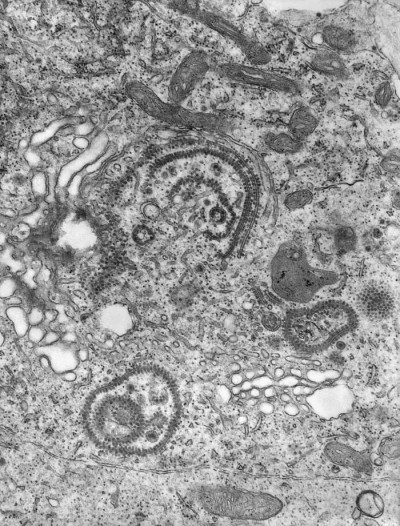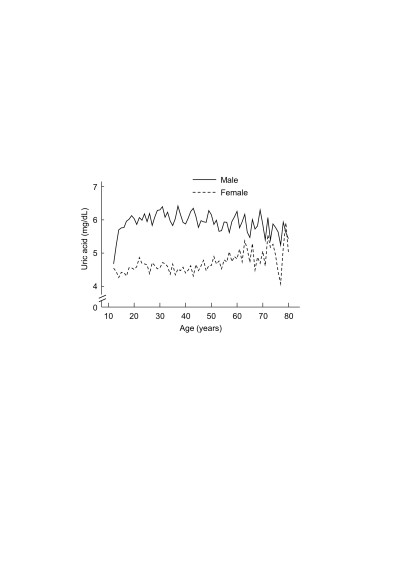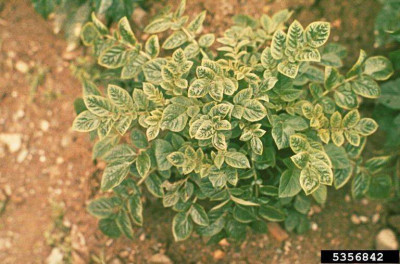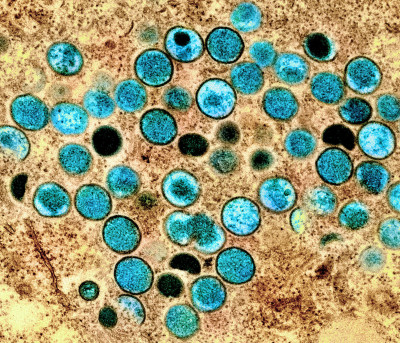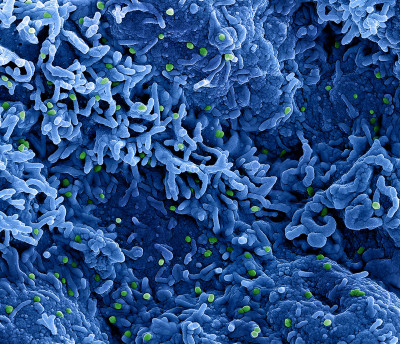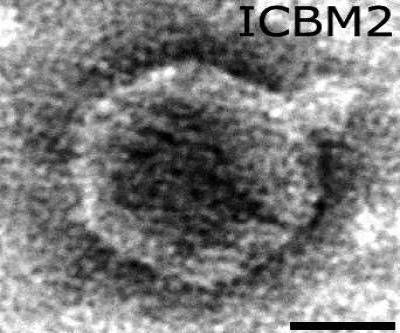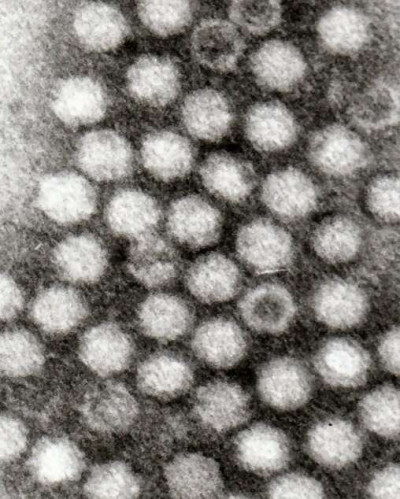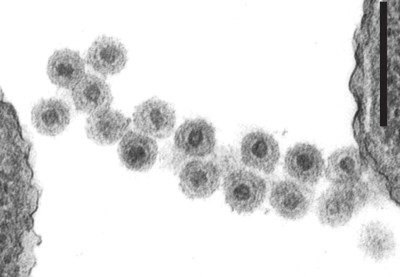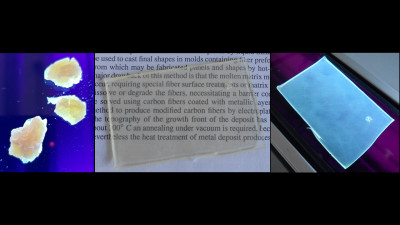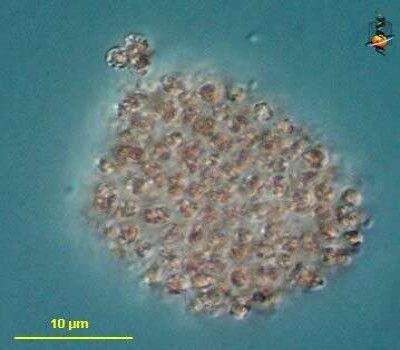Colorized transmission electron micrograph of monkeypox virus particles (gold) cultivated and purified from cell culture. Image captured at the NIAID Integrated Research Facility (IRF) in Fort Detrick, Maryland.
Wikimedia Commons, NAID
09 Apr 2024
Genome organization and characteristics of Sclerotinia sclerotiorum negative-stranded RNA virus 1. The position of each ORF is indicated above the negative-sense strand. The ORFs putatively encode six proteins: pI, NP (nucleoprotein), pIII, pIV, L (RdRP, RNA-directed RNA polymerase) and pVI.
Dàohóng Jiāng, María A. Ayllón, Shin-Yi L. Marzano3, and ICTV Report Consortium
18 Apr 2024
Genome organization of a representative betapartitivirus, Rosellinia necatrix partitivirus 11 (RnPV11/W98).
Wikimedia Commons, Paul Telengech, Sakae Hisano, Cyrus Mugambi, Kiwamu Hyodo, Juan Manuel Arjona-López, Carlos José López-Herrera, Satoko Kanematsu, Hideki Kondo, Nobuhiro Suzuki
18 Apr 2024
A computer reconstruction based on cryo-electron micrographs of a rotavirus particle (A) and a rotavirus particle reacted with a monoclonal antibody (B).
Wikimedia Commons, Graham Beards
24 Apr 2024
Capping pathway and enzymes in relation to the proteome of nidoviruses. The conventional mRNA capping pathway is shown on the left, with the enzymes catalyzing the respective four reactions listed in bold. Further to the right, presence of these enzymes in viruses of five nidovirus families, each designated by its prefix, is listed. RTPase, 5′-triphosphotase; GTase, guanylyl transferase; N-MT, guanine-N7-methyltransferase; O-MT, 2′-O-methyltransferase. In m7GpppN2’-Om notation, m7G stands for 7-methylguanosine, p stands for phosphate, N2’-Om stands for the 5′-terminal nucleoside of the RNA molecule, methylated at the ribose-2′-O position.
Wikimedia Commons, Anastasia A.Gulyaeva and Alexander E.Gorbalenya
29 Apr 2024
Colorized transmission electron micrograph of monkeypox virus particles (yellow and green) cultivated and purified from cell culture. Image captured at the NIAID Integrated Research Facility (IRF) in Fort Detrick, Maryland.
Wikimedia Commons, NAID
29 Apr 2024
TEM morphology of phage SH-Ab 15497, proposed/unclassified Siphoviridae.
Wikimedia Commons, Yunfen Hua, Tingting Luo, Yiqi Yang, Dong Dong, Rui Wang, Yanjun Wang, Mengsha Xu, Xiaokui Guo, Fupin Hu, Ping He
07 May 2024
Virions of Pseudomonas virus phi6. Scale bar, 100 nm.
Wikimedia Commons, Environmental Science & Technology
11 May 2024
Under the electron microscope, a section through muscle fibers and a blood vessel reveals detailed cellular architecture. Muscle fibers appear as tightly packed, elongated structures with visible striations, indicating the organized arrangement of actin and myosin filaments essential for contraction. Adjacent to these fibers, a blood vessel stands out, its endothelial lining clearly defined. Red blood cells are visible within the vessel, highlighting its role in oxygen and nutrient transport. This high-magnification image provides a striking view of the interplay between muscle and vascular systems, emphasizing their collaborative function in sustaining muscle activity and overall physiological health.
08 Jul 2024
Description: English: Microbes (mostly cyanobacteria) growing in cooled water near a hot pool. Date: 11 September 2022, 09:47:04. Camera location44° 24′ 00″ N, 110° 49′ 48″ W View all coordinates using: OpenStreetMap 44.400000; -110.830000.
Carpenter, Kenneth, Wikimedia Commons
18 Sep 2024
This transmission electron micrograph (TEM) revealed the presence of a number of Eastern Equine Encephalitis (EEE) virus virions that happened to be in a specimen of central nervous system tissue.
Public Health Image Library
11 Apr 2024
Serum levels of uric acid in males and females. [1] This cohort included 5 079 males and 4 393 females, which represented a weighted sample size of 101 696 911 and 82 645 299, respectively. Data represent the weighted mean values over each year of age from 12 to 80 years.
05 Mar 2024
Potato plant displaying symptoms of Potato Leaf Roll Virus, Peru and Bolivia.
Wikimedia Commons, William M. Brown Jr., Bugwood.org.
02 Apr 2024
Colorized transmission electron micrograph of monkeypox particles (teal) found within an infected cell (brown), cultured in the laboratory. Image captured and color-enhanced at the NIAID Integrated Research Facility (IRF) in Fort Detrick, Maryland.
Wikimedia Commons, NAID
08 Apr 2024
Colorized scanning electron micrograph of monkeypox virus (green) on the surface of infected VERO E6 cells (blue). Image captured at the NIAID Integrated Research Facility (IRF) in Fort Detrick, Maryland.
Wikimedia Commons, NIAID
09 Apr 2024
Transmission electron micrograph of uranyl acetate stained, free Lentibacter virus vB_LenP_ICBM2 (genus Veravirus, fam. Zobellviridae, ord. Caudovirales ). Scale bar: 25 nm. [1]
Wikimedia Commons, Vera Bischoff, Boyke Bunk, Jan P. Meier-Kolthoff, Cathrin Spröer, Anja Poehlein, Marco Dogs, Mary Nguyen, Jörn Petersen, Rolf Daniel, Jörg Overmann, Markus Göker, Meinhard Simon, Thorsten Brinkhoff, Cristina Moraru
10 Apr 2024
Thin-section electron micrograph of Pseudomonas phage phi6 particles attached to the pilus receptor of the host (right). The bar represents 200 nm.
Wikimedia Commons, M.M. Poranen and S. Mäntynen
10 May 2024
UV-Vis absorption, fluorescence, optical activity, etc. are physical properties very useful for technological applications. Frequently these useful physical characteristics can be found in molecular species. These special molecules could be named ‘functional molecules’ and can be used as ‘active principle’ for developing some types of functional materials. For example, technologically useful optical/photonic materials can be developed simply by trapping a functional molecule into a polymeric glass (i.e., an amorphous macromolecular solid specie). Both optical-grade thermoplastics (linear optical polymers) and thermosetting resins can be used for such a purpose. Epoxy resins, poly(methyl methacrylate) (PMMA), polystyrene (PS), polycarbonate (PC) are potential solid solvents. The only requirement for these macromolecular solvents is the possibility for the functional molecules to dissolve in it (with good solubility) in order to generate an homogeneous system (solid solution), that keep unchanged the optical grade. There are many natural substances that have extremely useful functional properties. Some natural molecules are characterized by optical absorption, fluorescence, phosphorescence, optical activity, thermo-chromism, photo-chromism, etc. Colophony is a natural molecule capable to combine the two required characteristics for making a photonic polymeric material: high compatibility with non-polar polymers and strong fluorescence. The ‘solution-casting technique’ can be used for preparing polymeric solid solutions based on thermoplastic systems. For example, the sample shown in the above images has been obtained by dissolving both a little amount of a commercial colophony (left-side picture) and poly(methyl methacrylate) powder in an universal solvent (chloroform, CHCl3) under stirring and the obtained viscous liquid solution has been cast onto a Petri dish of glass. After complete solvent removal by evaporation, a solid solution resulted. The material taken from the Petri dish bottom was shaped in form of film. As clearly visible, this film is perfectly transparent (see middle picture) and strongly fluorescent under illumination with ultraviolet light (see right-side picture). In particular, the colophony-PMMA solid solution is emitting blue light[1].
15 Jul 2024
Thiocystis is a red sulphur bacterium (or purple sulphur bacterium). It is found in sediments above the reduced zone. It oxidizes hydrogen sulphide producing elemental sulphur which is deposited within the bacterial cell as granules of sulphur. Forms aggregates and individual cells are often hard to distinguish.
David Patterson, Linda Amaral Zettler and Virginia Edgcomb, micro*scope
25 Jul 2024
 Encyclopedia
Encyclopedia
